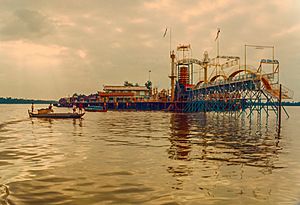Coconut Religion facts for kids
The Coconut Religion (called Đạo Dừa in Vietnamese) was a special religious group in Vietnam. It was based in southern Vietnam, in a place called Bến Tre Province. This group started in 1963. Its followers built a unique "Coconut Kingdom" on an island in the Mekong River.
The Coconut Religion mixed ideas from Buddhism and Christianity. Its founder, Nguyễn Thành Nam, taught people to be peaceful. At its most popular, about 4,000 people followed this religion. The government stopped the religion in 1975. Today, only a very small number of people still follow it.
What They Practiced
Followers of the Coconut Religion had a very interesting practice. They believed in eating only coconuts. They also drank only coconut milk. This was a central part of their daily life.
The Founder: Coconut Monk
The Coconut Religion was started in 1963 by a Vietnamese scholar named Nguyễn Thành Nam. He was also known by many other names, like the Coconut Monk. People also called him His Coconutship, Prophet of Concord, or Uncle Hai. He lived from 1909 to 1990.
Nguyễn Thành Nam went to a French university. After his studies, he created a floating temple in his "Coconut Kingdom." This was in the Bến Tre Province. It is said that he ate only coconuts for three years. During that time, he also meditated on a small stone platform.
The Coconut Monk was a unique person. He often wore a crucifix around his neck. At the same time, he dressed in traditional Buddhist robes. Even though he had unusual ways, the government in Saigon respected him. They called him a "man of religion."
The Religion's Journey
At its peak, the Coconut Religion had around 4,000 followers. One famous follower was John Steinbeck IV. He was the son of the American writer John Steinbeck.
In 1975, the government decided to ban the Coconut Religion. They saw it as a "cult." The Coconut Monk passed away in 1990. After his death, the religion became much smaller. Today, the old "Coconut Estate" is a place tourists can visit. It is part of the My Tho Mekong Delta Tour.


